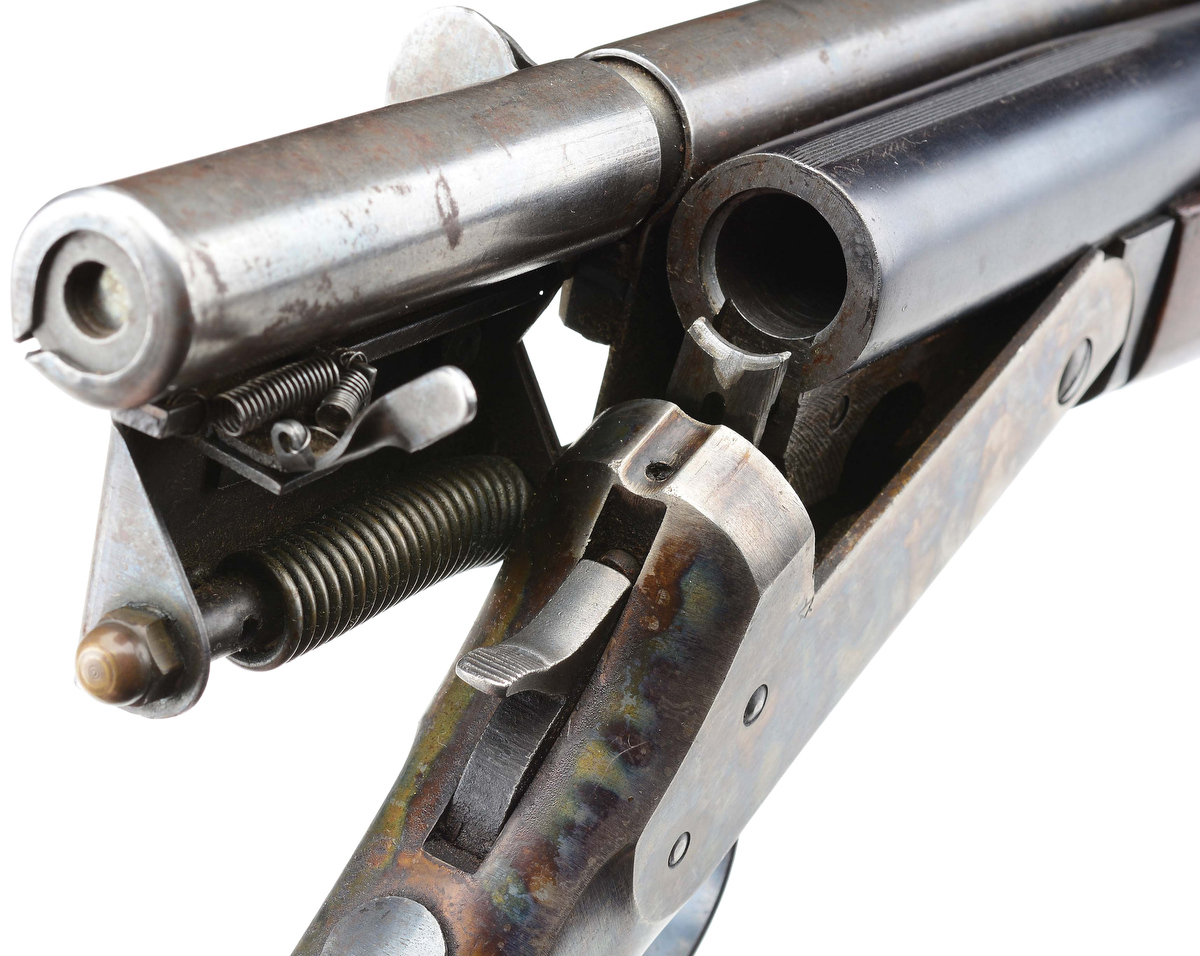By Steve Baughman
Sometimes the eye only sees part of a scene. This article summarizes efforts to produce thermal images of heat distributions generated by three different suppressor designs, as well as visually explores the heat generated by full-auto fire on a suppressed M-16 carbine.
The first “Predator” movie starred Arnold Schwarzenegger as a commando team leader on a special mission in a remote corner of the world. In this movie, the hunters became the hunted. Their adversary used a cloaking device to make itself invisible, and also survived one of the best firepower demonstrations I’ve ever seen in a movie. Although strictly Hollywood, the portable mini-gun was really fun to watch burning up the jungle. Several scenes in the movie showed the “predator’s eye-view” of his prey. These scenes were not just made-up Hollywood special effects. They were produced with an infrared (IR) camera, which shows the heat emitted from the objects under view. The camera settings were modified to give the appearance of a slow motion, fluid-like movement of the people being stalked.
Doug Olson’s excellent article on Qual-A-Tec Suppressors in the Vol.1, No. 2 issue of Small Arms Review discussed several technical issues related to thermal heat-flow and temperature reduction as they relate to suppressor efficiency. He stated that the more efficient suppressors will get hotter in fewer shots than less efficient ones, and this excessive heat build-up can be a problem, especially for extended full-auto fire. Material selection, baffle design, and dimensional considerations are the main issues a designer must consider. The design must provide an efficient way to absorb heat from intimate contact with the gas as it travels through the device, yet at the same time conduct the heat rapidly towards the outside and away from it.
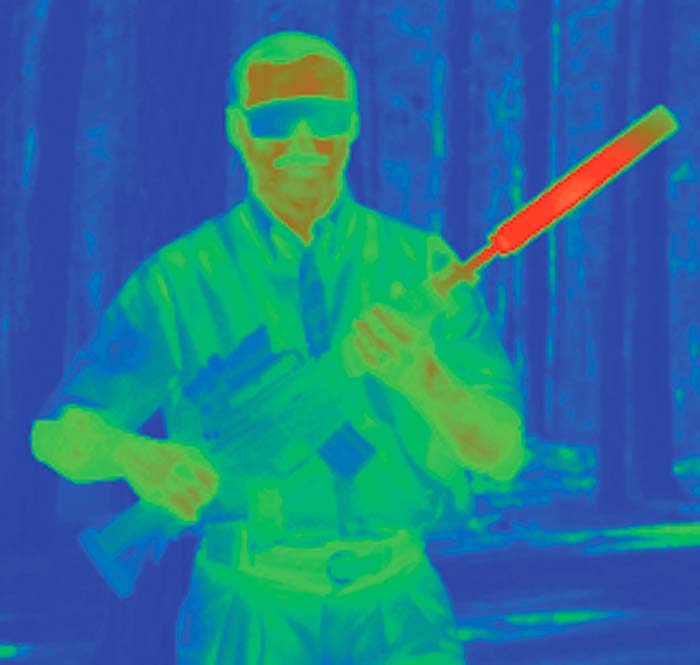

Doug’s comments on temperature reduction really sparked my interest as my “real” job involves the use of infrared technology at a major aerospace/defense company. Could there be some way to relate temperature reduction and suppressor efficiency? What if you could measure the temperature flow through the various baffle configurations to check the efficiency of the design? Since you normally can’t “see” temperature differences with the naked eye, I set out to perform an experiment to produce thermal images of several suppressors “in real-time” during a shooting session using specialized infrared equipment. Muzzle blast noise is caused by the hot, high-pressure propellant gases in the bore escaping out of the barrel during firing. The suppressor reduces this pressure, and the result is substantially decreased noise levels. The pressure is reduced by the following, each of which contribute to the efficiency of the design:
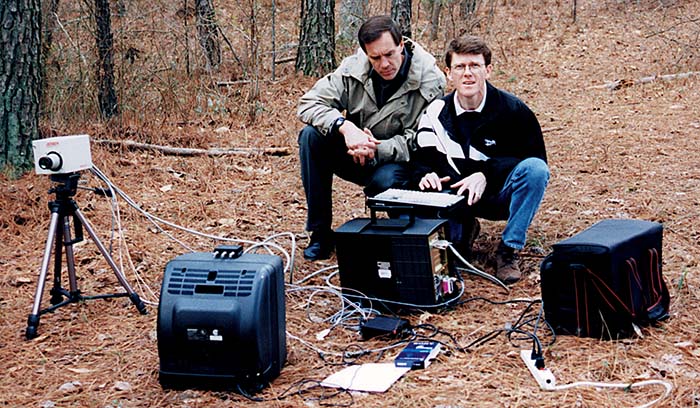
Sequence 1: Gentech Specop II Suppressor & M-16 Carbine.
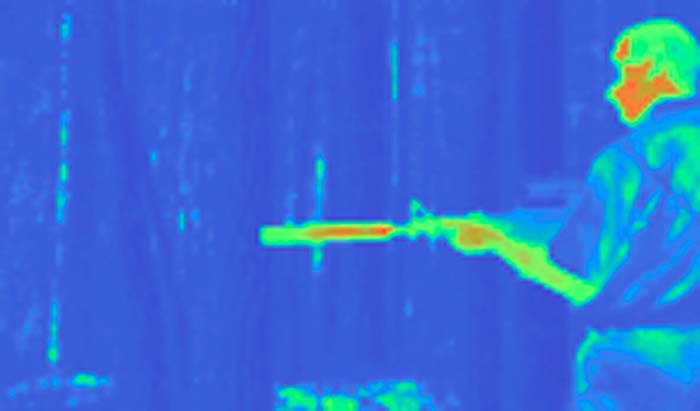
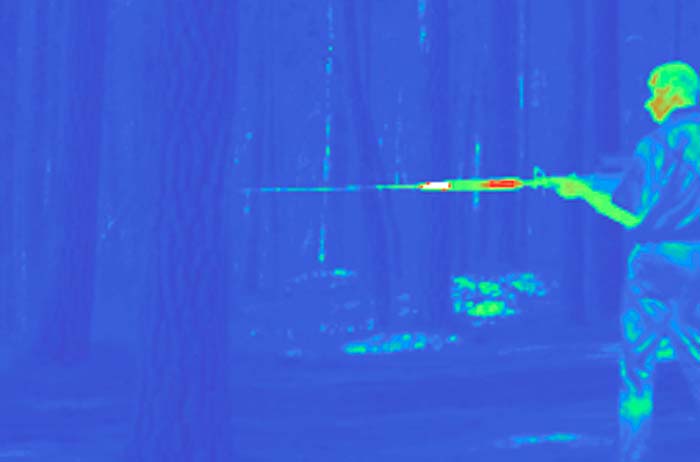
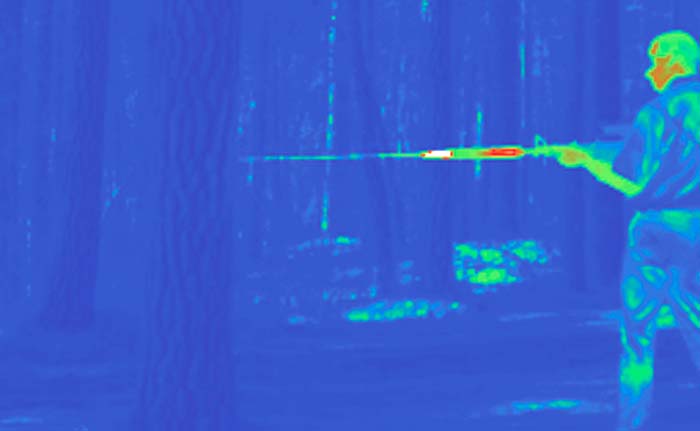
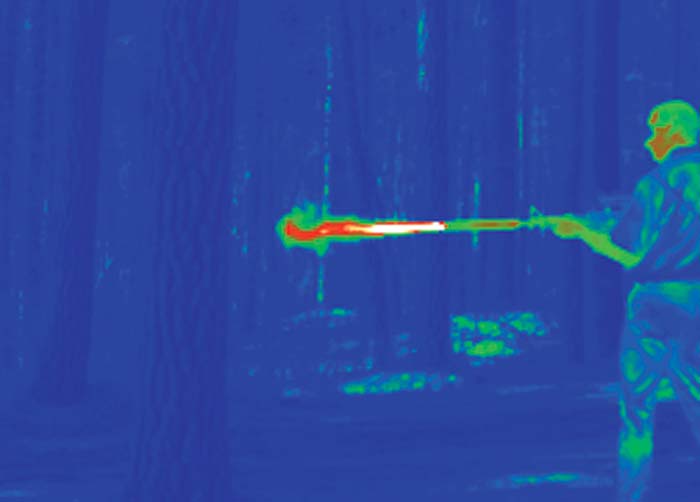


M-16 time sequence showing thermal results from firing a single shot. View 1 is prior to shot being fired. Views 2 and 3 show bullet trajectory and immediate heat buildup in suppressor. View 3 shows main muzzle blast leaving suppressor just behind the bullet. View 4 shows continuation of main blast. View 5 shows main blast dissipating, as well as secondary blast turbulence. In view 6, 5 empty casings can be seen suspended in mid air following a 5-round, full auto burst.
1. Cooling blast temperature
2. Delaying gas exit through trapping and turbulence
3. Increasing volume available for the gas to expand.
A visit to the John Browning Firearms Museum in Ogden, Utah was actually the accidental starting point of this investigation. The standard tour includes a narrated “walk-through” in the gun viewing areas, a view of Browning’s original workshop, and a film on his life as it relates to firearm design. Bert was our tour guide, and he is very knowledgeable about Browning firearms and history. He has volunteered over 8300 hours of his personal time to the museum. If you ever visit this facility, be sure to also take in Norm’s train talk. Norm also knows the Browning story very well. He has over 18,000 hours of volunteering his time at the museum. Some say he actually lives at the museum, and I believe it.
John Browning realized the blast energy coming out of the muzzle of a gun could be utilized as a useful tool. He harnessed this energy to develop self-loading mechanisms, which ultimately resulted in the development of his machine guns. I got to thinking about using this blast energy, and about a way to possibly measure the cooling effects of a suppressor.




Sound Technology MK II Pistol, Views 1, 2 & 3: Thermograms showing a series of three shots. Note progressive heat buildup just ahead of the chamber region. View 4 illustrates same, as well as 5 cartridges in mid air.



Sound Technology MK II Pistol, First shot shows initial heat buildup in main internal blast chamber. Hot gasses shown escaping during extraction of empty casing. Second shot illustrates hotter buildup in main internal blast chamber.
Amber infrared camera
When materials get hot, they radiate energy in the infrared portion of the electromagnetic spectrum, and if they get hot enough, in the visible spectrum (glowing metal). For example, the blacksmith knows from the color of a heated piece of metal when it is time to quench and temper. Similarly, I’ve seen belt-fed shooters on the line at Knob Creek heat-up a barrel until it glows red. When firing a long full auto burst through a suppressor, the tube is too hot to handle with bare hands for several minutes. This heat can be defined as thermal energy that is on the move: it flows from one place to another. Infrared (IR) cameras can be used to view the thermal response of an object in the invisible part of the spectrum between what our eyes can see and radio waves. Equipment for this type of work is getting smaller and smarter, and makes field-testing much more convenient than ever before. The evolution of instruments which measure temperature has been very dramatic over the last few years, primarily stimulated by military and space applications, as well as the growing demand for faster and more versatile industrial applications.





The IR camera measures variations in heat emitted by the suppressor’s outer surface, and transfers these variations into electronic signals that can be digitally recorded and visually reviewed. By capturing a rapid series of IR images, one can track the progress of the heat generated through the firearm. Areas of high heat can be monitored, and the turbulence produced by the blast gasses can be viewed. Since a suppressor rapidly cools a lot of the heat generated by the cartridge, the thermal data may be used to help the designer determine the efficiency of the unit as it captures the explosive gases. One can monitor heat buildup by observing the thermal variations as the gun is fired. An additional application for Special Ops groups is monitoring the infrared signatures of their positions (or others) when engaged in live firing situations. A discharged firearm shows up like a spotlight in the darkness when viewed through an infrared camera. Potential applications abound within the surveillance and firearms industry. An Amber Radiance HS focal plane array infrared camera was utilized to take the images for this article. Amber Engineering was founded in 1981, and is based out of Gallate, California. The Radiance HS camera is totally self contained and weighs less than 9 pounds. Extra sensitivity is required when monitoring the fast heat transfer, which takes place when a gun is fired. The camera has a very fast frame rate, and can detect temperature changes as small as 0.02 o Fahrenheit. The Radiance HS represents state-of-the-art equipment and is not inexpensive. Two Amber technical representatives donated an afternoon of their time to help me take the data for these tests.
Real-time monitoring under actual firing conditions provided us with some interesting insights into heat distributions which progressively develop due to the mechanisms involved in the firing process. As mentioned before, our goal was to see the heat distributions around the internal baffles and chambers, but we actually saw more than that. The main heat blast and resultant turbulence coming out of the barrel were also observed. Capturing this thermal information had to be done quickly after firing, due to the rapid disbursement of the heat throughout the suppressor, or the thermal details of internal structure would be lost as the weapon warmed up from repeated firing. Some timing coordination was required between the shooter and the recorder. Most thermal data sets were recorded in 15 seconds or less, so the time between the first shot and the last shot fired had to be done quickly.
We evaluated three different designs during this test. The first was a Sound Technology integral Ruger MkII pistol. The second was a Gemtech Vortex-2 muzzle can mounted on a Ruger 10/22 rifle. The third was a Gemtech SpecOp II mounted on an M-16 carbine. Each shot generated fantastic images of the blast heat leaving the muzzle, and the hot cartridge case and burning powder flying out of the chamber area. It was amazing to see the captured images of hot propellant gases flying out of both the muzzle and chamber. Speeding up the camera frame rate, we also captured images of the bullets in flight before hitting the backstop 30 yards away. We could see the bullet’s trajectory from muzzle to target. The bullet in flight was hot enough, and the camera frame rate was fast enough, to provide a contrast against the outside air temperature. We could also observe both a primary and secondary blast coming out of the M-16 for each shot fired. The turbulence generated by the suppressor was phenomenal.
The M-16 was fired with 5 rounds on full-auto for each test. After the first shot left the muzzle, we could immediately see the warm up of the first blast chamber in the rear of the suppressor. The next 4 shots really warmed things up, and we could then see the heat flow rapidly from the rear to the muzzle end of the SpecOp. A red-colored, vertical heat wave was observed moving from rear to front of the unit. This phenomenon took place about 5 seconds after the last round left the gun. After about 10 seconds had elapsed, the entire unit showed fairly uniform heat distributions from end to end. We repeated this test five times with the same results. The infrared camera showed that the main blast coming out of the SpecOp looked like a flame-thrower.
On Mark White’s (Sound Technology) integral Mk II pistol, the first 3 inches ahead of the chamber region showed a very large heat gain immediately after firing rounds as fast as I could pull the trigger. The area ahead of this region remained remarkably cool all the way to the muzzle, even after 10 shots. This test was repeated three times with the same results. Apparently, Mark’s unit is designed such that it captures most of the heat energy just ahead of the chamber. There was less heat transfer beyond that portion of the suppressor. As far as heat flow is concerned, his design captures and disperses the heat close to the chamber area.
Ten rounds were then fired through the 10-22 rifle with the Vortex-2. As before, the first chamber showed a large heat gain immediately. With the Vortex-2, each individual chamber could then be seen since the heat flow was remarkably uniform from end to end. The other interesting observation on the Vortex-2 was that the last chamber just behind the muzzle also showed a higher temperature than the center region, probably due to the internal turbulence that is generated towards the end of the unit.
As suspected, the early chambers of each unit always showed the largest heat gains. As the area just ahead of the chamber in a gun barrel always gets hottest, we would expect that the area just ahead of the muzzle (initial blast chamber) in the suppressor would get hottest as well. Stop most of the main blast here, and there is less thermal energy to deal with down the line. Each firearm was allowed to cool to ambient temperatures between tests.
I have long felt that the material used in a suppressor has a significant impact on its efficiency. A material’s thermal conductivity can be simply defined as its ability to conduct heat. Aluminum conducts heat at a much faster rate than stainless steel. The “heat spike” which occurs when the round is fired is due to the compressing and heating of the air in the barrel. This heat spike and subsequent cooling takes place so rapidly that the fast IR camera is a reliable way to “see” what is transpiring.
The preceeding thermal images can be classified as “thermograms”. They are a way to observe the infrared energy radiating from the surface of the objects. The different color levels represent different temperature ranges. The colors range from hot to cool in the following order: white (hot), red, yellow, green, blue, and purple (cool). We were all truly amazed as we viewed the digital video playback of the guns firing. We could observe the heat generated in slow motion, as well as the hot blast gasses leaving the muzzles. After reviewing each data set, we printed a color copy of some of the most interesting observations. Although we obviously can’t reproduce every one here in the article, those that do make it to print will give an idea of what we’re talking about. Somehow though, the printed thermograms just don’t do justice for what we observed. Perhaps recording to CD would be the best way to present this type of information.
We all agreed that the next step is to obviously repeat future activities in a controlled laboratory condition, and to correlate the observed heat flow with sound measuring equipment. Our efforts were just an informal trip into the woods for an afternoon of shooting fun, and to generate some interesting images. Those interested in pursuing and exploring this technology are encouraged to contact Amber.
Special thanks go out to Mike Larson of Advanced Infrared, Inc., and Roy Malmberg of Amber for providing use of the IR camera and related test equipment. Mike’s company provides state-of-the-art infrared radiometers for commercial and industrial uses. Roy is the Regional Sales Manager at Raytheon Amber in California. They both invite those who envision applications for advanced infrared imaging in both military and commercial fields to contact them. Mike can be reached at P.O. Box 801038, Acworth, GA 30101, or phone 770-975-4737. Roy can be contacted at 5756 Thornwood Drive, Goleta, CA 93117, or phone 805-692-1395.
| This article first appeared in Small Arms Review V1N12 (September 1998) |





